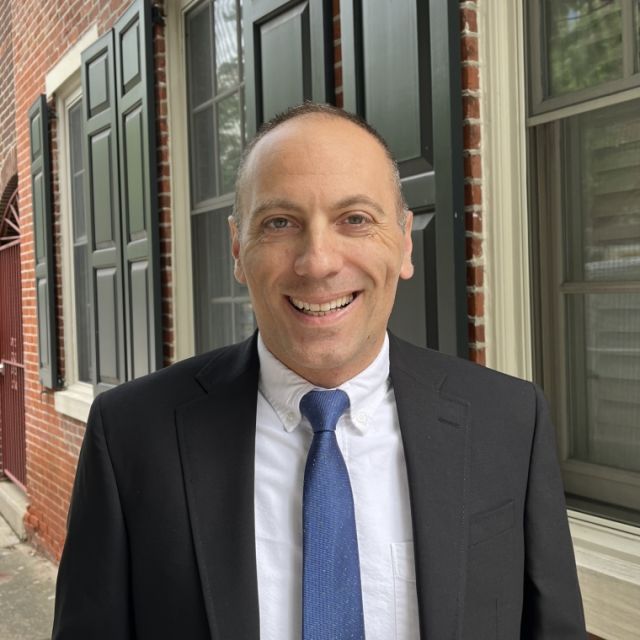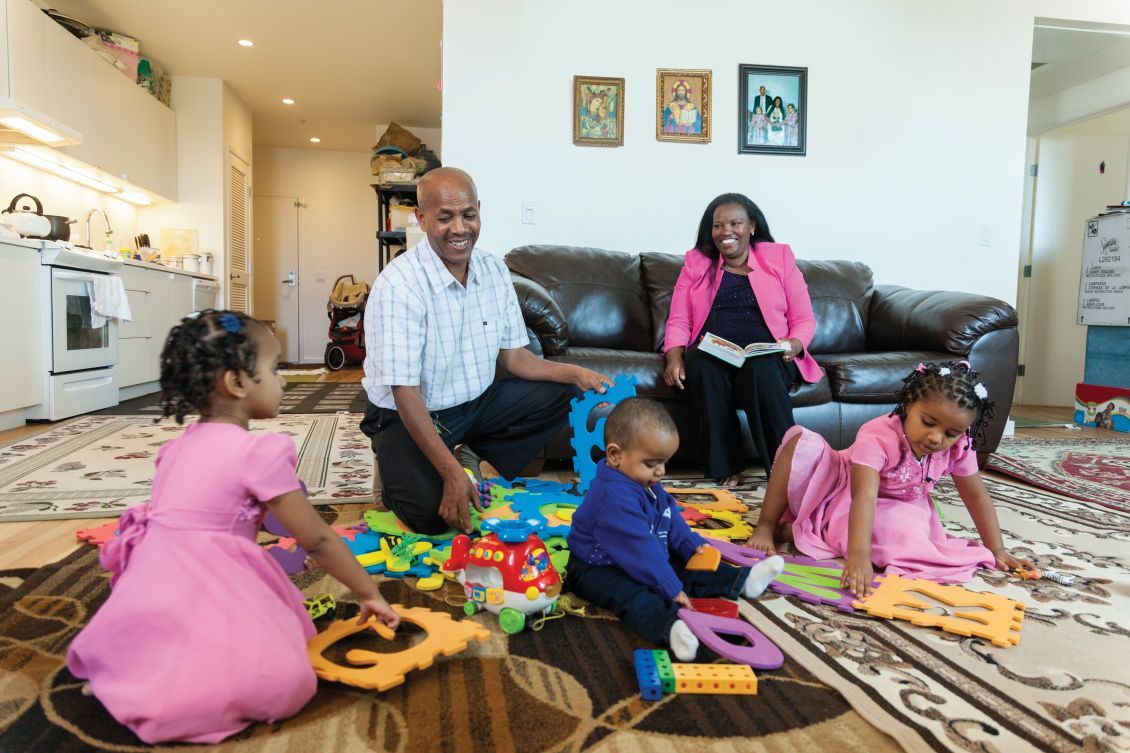Working as an AmeriCorps intern with youth living in public housing in New York City’s Chelsea neighborhood amid rising hypergentrification opened Vincent Reina’s eyes to the necessity of collaborating across systems. He saw firsthand the dynamics that shape our ability to access a safe, stable home, enter the labor market, and gain upward mobility.
“The pivotal role that housing plays in individual development as well as community and regional development really hooked me,” said Reina, associate professor of Planning and Urban Economics at the University of Pennsylvania and founder and faculty director of the Housing Initiative at Penn (HIP).
Reina co-designed PHLHousing+, a Philadelphia pilot program created to test direct-to-tenant, cash-based housing assistance with the Philadelphia Housing Development Corporation (PHDC), and is evaluating its impact with Sara Jaffee and Matt Fowle at Penn.
Together with Reina, Enterprise Senior Director of Upward Mobility National Programs Alexa Rosenberg co-leads a monthly “big tent” meeting that explores ways to advance rental assistance reform efforts like PHLHousing+. Rosenberg spoke with Reina about the history of direct rental assistance (DRA), why it has drawn renewed interest from HUD and beyond, and how to ensure it’s part of a larger constellation of support for families in need.
Tell us what direct rental assistance is and how it differs from Section 8. What excites you about this model?
The Section 8 Housing Choice Voucher [HCV] program is designed so the tenant pays 30% of their income for housing. The difference between that tenant payment and the HUD-approved rent levels flows directly to the owner through an agreement the owner signs with HUD. So even though it's a demand-side subsidy, the subsidy portion goes directly to the owner. Direct rental assistance is when that rental assistance payment flows directly to the tenant.

What excites me about the DRA model is that it's pushing rental systems in a new direction that aligns more closely with traditional demand-side-assistance-based subsidy and presents a keen opportunity to learn whether and how this works, and what that means for expanding the suite of rental assistance options.
When HUD created the modern-day Housing Choice Voucher program in the early ’70s, it was experimenting with something that looked a little more like DRA.
Can you share more about HUD’s early thinking on this model?
DRA is not new. Before the voucher program was created more than 50 years ago, HUD created the Experimental Housing Allowance Program [EHAP] to inform what would ultimately become a demand-side, assistance-based program. Interestingly, HUD created the Section 8 voucher program in its current form before it knew the results of the EHAP, which included DRA-type models.
In many ways, DRA aligns with traditional economic theory so it’s an exciting opportunity to test this model in the current context, particularly considering some of the well-documented challenges we’re seeing in the HCV program.
Let’s talk about PHLHousing+, the DRA pilot that you and others helped design in Philadelphia. How did it come to be? What’s unique about the pilot?
In Philadelphia, the idea of DRA emerged in 2019. A fellowship from the Stoneleigh Foundation allowed me to embed myself with the city of Philadelphia to think about cross-system programs to advance youth outcomes. There was a desire to think creatively about programs that would complement existing ones, like the voucher program. Section 8 vouchers work very well for many households. But there's a large share of households who can't access a voucher – and even when offered one, can’t use the voucher on the private rental market.
Together with the Philadelphia Housing Development Corporation – the city agency that would ultimately administer the DRA program – we co-designed PHL Housing+, thought through implementation, and envisioned and embedded the research component. This represented a distinct and unique partnership between academia and local government. At that time, we were really pushing the envelope, so there was a lot of concern and skepticism because in the housing field, which is under-resourced, we’re often nervous about innovation coming at a loss of things that are working well.
In March 2020, [former] Mayor [Jim] Kenney announced that the city would support a five-year $35 million DRA program for 1,000 households – a week before the city shut down due to the COVID-19 pandemic. So this program we'd spent over a year developing was all of a sudden put on hold.

So what then?
Fortunately, Philadelphia really hit the ground running using its emergency rental assistance [ERA] resources. My partnership with the city around DRA translated perfectly into a partnership around ERA. Very early on, my team helped the city realize they could offer ERA directly to a tenant, a model only Chicago had tried through a small program at that point.
For us, it was a powerful inflection moment. Given many places were having a difficult time contacting owners, or getting owner consent for ERA, we were able to make a clear case of why a DRA model could be good to test, and how most concerns about the approach were based on hypothetical scenarios of what can go wrong rather than empirical evidence.
The team that had worked on the initial concept didn’t want to lose the opportunity for a DRA pilot, though, and the mayor’s office supported PHDC to seek other sources of funding to stand up the program. The city funded over half of the pilot with flexible public funds from local bond proceeds and its Housing Trust Fund. The Spring Point Partners Foundation gave a large grant. The Stoneleigh Foundation was already supporting my research. The William Penn Foundation gave a large grant. Through all these sources, the team was able to put together a program that ultimately took a smaller form.
There was also a clear recognition that we should not miss the opportunity to study this model, so we received funding to add Professor Sara Jaffee, one of the national foremost developmental psychologists, to our team. PHDC launched the program in 2022 with 300 households receiving cash structured like a voucher, and we’re now a year and a half into the program.
At midstream, what insights have you drawn to date about the DRA pilot?
One thing we learned early on is that these programs take a while to develop and require an intentionality about the details. The team had to talk through the mechanics of every aspect. What are the rent limits on the program? What kind of documentation would PHDC require? We had many long conversations about what the program is and isn’t, and what we're testing and not testing. PHDC also had its ERA infrastructure in place – its staffing, technology, experience making digital applications accessible, etc. – which was a key part of making this work.
Households have different needs at different points in time ... No one program can solve every need.
Second, partnership with a city committed to making evaluation part of the program’s structure is critical. Philadelphia made that commitment from day one and, ultimately, it’s going to allow us to produce the evidence base from this pilot that will inform programs going forward.
Finally, even though we're optimistic this program will improve folks’ outcomes across several metrics, no program is perfect. Households have different needs at different points in time. Some of those are emergency needs. Some are long term. Some needs are better served by subsidies that flow directly to an owner and others by subsidies that go directly to a tenant. No one program can solve every need.
Why is now a good moment for more DRA experimentation?
There is a lot we can apply from ERA to new models, and DRA allows for that. There also seems to be a unique moment now where the federal government, and local governments, are interested in exploring new, innovative models. For something like DRA to scale, you're going to need some form of federal lever and connection, as well as local commitment. The fact that HUD saw what we are doing and decided to lean in and give flexibility for more public housing authorities to try this is not something we expected in 2019. We’re hoping the evidence base we're building helps inform what that can look like and at what scale.
What else beyond HUD’s support is needed across the national ecosystem to advance DRA?
Spaces where folks can learn about DRA and how it works are fundamental. A lot of public agencies are under-resourced and overworked. The idea of developing a whole new program, especially one that isn't coming with new resources and new funding to cover administrative costs, is daunting.
Open spaces where those conversations can happen well before the program develops are critical. Spaces like the national “big tent” calls – that were initiated by HUD and now co-hosted by Enterprise and HIP – are a useful starting point for both advancing the conversations and having people think about whether DRA makes sense for their market and what form it could take.
Entities like Enterprise and HIP have a lot of technical expertise on housing programs, often across geography, and can ensure that the conversation about DRA sits within a broader one around innovation and all forms of rental assistance in the housing ecosystem. And baked into our model at HIP and your model at Enterprise is sincere engagement with the folks who are doing the work.
I love what you're saying about the housing ecosystem. We talk a lot about needing a more supportive ecosystem and spectrum of supports – especially if you're thinking about housing as a platform for upward mobility.
Situating DRA as a potential tool within an expanded set of resources is essential to advancing our goals of increasing housing security and stability and supporting upward mobility. The goal of our monthly calls is to create space where people can ask both broad and nitty-gritty questions about developing innovative programs like DRA so we can expand those resources and do it in a thoughtful way.
Read Enterprise's comments in response to HUD's Request for Information on direct rental assistance.
